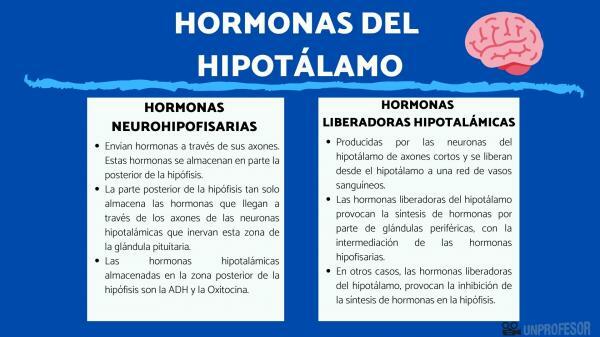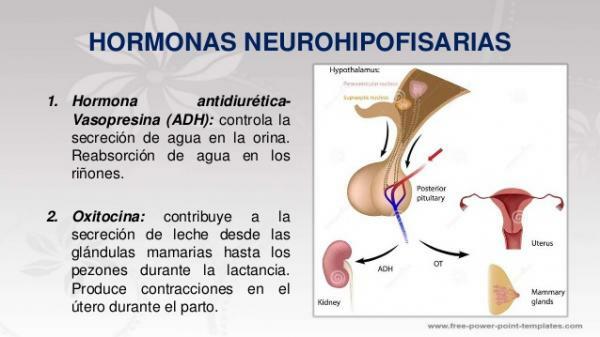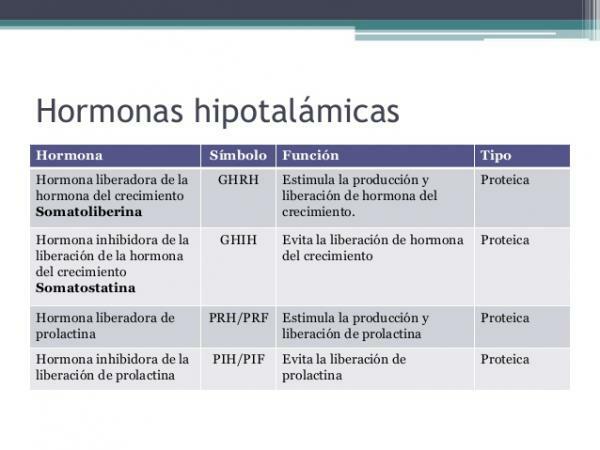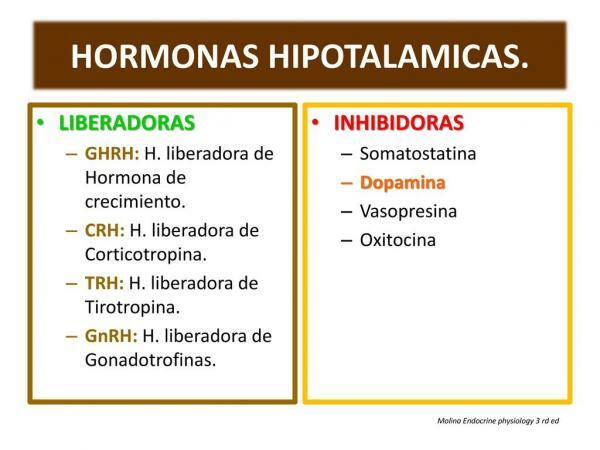Functions of HORMONES of the hypothalamus

The hormones They are the chemical messengers of the body. They are produced in certain organs (endocrine glands) and regulate the functioning of other organs or tissues, which are called target organs or tissues. But… Where does this exquisitely precise control mechanism start? In this lesson from a TEACHER we will discover that it is in a small structure of the brain called the hypothalamus and we will see what they are. the hormones of the hypothalamus and their functions.
Index
- What are the characteristics of the hypothalamus?
- What are the hormones produced by the hypothalamus? Neurohypophyseal hormones
- Hypothalamic releasing hormones
- 6 types of hypothalamic releasing hormones
What are the characteristics of the hypothalamus?
Before knowing the functions of the hormones of the hypothalamus, we are going to know the characteristics of this brain region. The hypothalamus is a small region of the midbrain located in the brain base very close to the pituitary gland (also called the pituitary gland).
The hypothalamus acts in response to the information that comes from different parts of the body by producing hormones, to control the functioning of the endocrine organs peripherals such as the thyroid glands, the adrenal glands; and other organs such as the kidneys, reproductive organs, and the musculoskeletal system.
The secretory neurons of the hypothalamus They are of two types:
Neurons that synthesize neurohypophyseal hormones
It is a kind of neurons hypothalamus, with long axons that connect to the back of the pituitary gland, from where they are released neurohypophyseal hormones, which enter the bloodstream to reach various target tissues scattered throughout the body.
Neurons that synthesize hypothalamic releasing hormones
Another type of hypothalamic secretory neurons are short axon neurons that do not leave the hypothalamus. These neurons release the calls hypothalamic releasing hormones, in the hypothalamus itself, from where they pass into the bloodstream through a network of local blood vessels called pituitary portal system. The hormones released in this vessel system reach the anterior part of the pituitary where they cause the synthesis of the calls tropic or trophic hormones, which will regulate the activity of tissues and peripheral glands.
What are the hormones produced by the hypothalamus? Neurohypophyseal hormones.
Hormones from the hypothalamus, whose axons extend to the back of the pituitary gland, send hormones through their axons. These hormones are stored in the posterior part of the pituitary.
The posterior part of the pituitary does not synthesize any hormones on its own, but only stores hormones that arrive through the axons of the hypothalamic neurons that innervate this area of the pituitary gland. The hypothalamic hormones stored in the posterior area of the pituitary are the ADH and Oxytocin.
ADH (antidiuretic hormone), Vasopressin or Arginine vasopressin (AVP)
ADH is a nanopeptide (It is formed by the union of nine amino acids). This hormone regulates the osmolarity of the internal environment. That is, the amount of water and solutes that the internal environment of the body contains. Also regulates blood pressure, controlling plasma volume through fluid retention in the kidney and also controlling the level of vasoconstriction of veins and arteries.
In addition to these well-known functions, increasing data suggest that vasopressin along with oxytocin, could be involved in the regulation of social, parental and sexual. For example, it seems that both vasopressin and oxytocin play a fundamental role in the recognition of family individuals.
This hormone is released from the pituitary, where it is stored, as a result of different types of stimuli:
- Regulation by osmotic stimuli: When the salt concentration in the internal environment is high, the synthesis and secretion of Vasopressin occurs that travels through the bloodstream. Through the bloodstream, vasopressin reaches your target organ: the kidney. In the kidney, this hormone causes a increased water reabsorption in the tubular system of this organ. In this way there is an increase in blood pressure and an inhibition of urine formation. The retention of water by the kidney produces a decrease in the concentration of salts in the internal environment, since the amount of water increases.
- Regulation by non-osmotic stimuli: In addition to an increase in the dissolution of salts, vasopressin is also released when the blood pressure is low. The action of vasopressin, which causes an increase in water retention in the kidneys, increases blood volume and this causes an increase in pressure.
Oxytocin
The second neurohypophyseal hormone is oxytocin, it is a hormone related to reproduction and upbringing. The release of oxytocin during the delivery provokes uterine contractions. Subsequently, the high concentrations of oxytocin in the bloodstream, stimulates milk production at the level of mammary glands. Oxytocin is also responsible for the ejaculation.

Hypothalamic Releasing Hormones.
The second group of hormones of the hypothalamus is the so-called group of releasing hormones. These hormones are produced by short axon neurons in the hypothalamus and are released from the hypothalamus into a network of blood vessels called pituitary portal system. This blood vessel system is a local network of vessels that lies between the hypothalamus and the pituitary gland (also called the pituitary gland).
In almost all cases, releasing hormones from the hypothalamus cause the synthesis of hormones by peripheral glands, with the mediation of pituitary hormones. In other cases, the releasing hormones of the hypothalamus, cause the inhibition of hormone synthesis in the pituitary.
The mechanism of hypothalamic releasing hormones
- The hypothalamus receives certain signals from the rest of the body that causes synthesis of a certain releasing hormone. Once synthesized, hypothalamic hormones pass into the bloodstream of the pituitary portal system and from there they are transported to the anterior part of the pituitary gland (hypophysis).
- In the anterior part of the pituitary releasing hormone causes release of tropic hormones which, in turn, are discharged into the bloodstream through which they travel to the target tissue or organ (peripheral glands). Or, in some cases, the inhibition of their synthesis.
- Once the tropic hormones reach the peripheral glandsstimulate the secretion of hormones in these organs.

6 types of hypothalamic releasing hormones.
To know the functions of the hormones of the hypothalamus you have to know the different hormones that exist. Here we discover the different types of hypothalamic releasing hormones. You should know that there are six different ones:
Corticotropin-releasing hormone (CHR)
Corticotropin-releasing hormone (CRH) provokesACTH secretion (adenocorticotropin hormone) by the area previous of thehypophysis. This pituitary hormone increases its levels during pregnancy and childbirth and also plays an important role in stressful situations. The action of ACTH on Kidney glands causes the Liberation ofcortisol by these glands (glands located in the upper part of the kidneys).
On CHR synthesis stress situations by the hypothalamus, it also causes growth of the adrenal glands, to increase the synthesis of cortisol.
Gonadotropin Releasing Hormone (GnRH)
Gonadotropin-releasing hormone secreted by the hypothalamus, causes synthesis and release by the anterior pituitary of two different hormones: FSH (follicle-stimulating or follicle-stimulating hormone) and the LH (luteinizing hormone). These two hormones influence the functioning of the gonads (organs that produce gametes or sexual reproductive cells). They cause the testosterone secretion in the testiclesand the estrogen and progesterone secretion in theovaries.
At the beginning of adolescence, the hypothalamus begin to intermittently synthesize the hormone GnRH that sets in motion a series of processes that lead to the development of the gonads and increased synthesis of sex hormones, in addition to body development. Gonadotropin-releasing hormone release during adolescence is also associated with sudden mood swings and "emotional chaos" that characterizes this stage of development.
Prolactin Releasing Hormone (PRH)
Prolactin-releasing hormone (PRH) is secreted by the hypothalamus and triggers prolactin release in the anterior pituitary.
Prolactin, in women, stimulates milk production in the mammary glands, it is also involved in the development of maternal behaviors.
Growth factor releasing hormone (GHRH)
GHRH is also known as somatotropin-releasing hormone (SRH). GHRH is synthesized and released in the pituitary portal system from where it reaches the anterior pituitary. In the pituitary gland, GHRH triggers growth hormone (GH) synthesis and releases it into the bloodstream, distributing it throughout the body. Many organs and tissues have receptors for this hormone and respond to it stimulating development of tissues mainly during sleep.
Growth factor inhibitory hormone or somatostatin (SSR)
It is a hypothalamic hormonewith inhibitory action. When the somatostanin (SSR) is released into the bloodstream and reaches the anterior pituitary, producing the inhibition of the synthesis of growth factor (GR).
Thyrotropin Releasing Hormone (TRH)
Thyrotropin-releasing hormone synthesized in the hypothalamus, stimulates the release of thyrotropin (TSH) into the bloodstream from the pituitary. This pituitary hormone causes the thyroid glands to synthesize and release thyroid hormones. Thyroid hormones affect all cells in the body, regulating a multitude of biological functions:
- They play a fundamental role in the development of the cerebral cortex. The deficiency of thyroid hormones causes serious neurological alterations such as: deficits in hearing and speech, motor defects and mental deficiency.
- They regulate the rate at which cells consume energy, which affects weight gain or loss.
- They can regulate the rhythm of your heartbeat.
- They control body temperature.
- They influence intestinal peristalsis, affecting the speed at which food travels through the digestive tract.
- They control the way the muscles contract.
- They control the rate of cell turnover when they die.

If you want to read more articles similar to Hormones of the hypothalamus and their functions, we recommend that you enter our category of biology.
Bibliography
- Hershel Raff, Michael Levitzky (2013). Medical physiology. An apparatus and systems approach. Madrid: McGraw-Hill Interamericana de España S.L.
- Carmen Agustín Pavón. (2015). Of "love hormones" and Christmas family reunions. SciLogs PSYCHOLOGY AND NEUROSCIENCE.
- Ulrich Boehm. (2013). The puberty switch. Mind and brain. Barcelona: Scientific Press S.L.
- Carmen Agustín Pavón. (2016).From the maternal brain. SciLogs Psychology and Neuroscience.
- Pere Berbel. (2003). Intelligence hormones. Metabolism. Mind and Brain. Barcelona: Scientific Press S.L.
